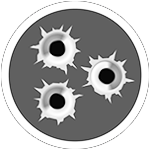
Swede
Active Member-
Posts
32 -
Joined
-
Last visited
-
Feedback
100%
About Swede
- Birthday 12/11/1948
Profile Information
-
Location
Shelbyville, TN
-
Gender
Not Telling
Recent Profile Visitors
The recent visitors block is disabled and is not being shown to other users.
Swede's Achievements

Just Getting Started (2/5)
25
Reputation
-
8mm 1950s Bulgarian Surp – Save For Reloading or Sell?
Swede replied to GS455's topic in Ammunition and Reloading
I broke down some '55 Yugo 8x57mm and reloaded the bullet and a slightly reduced and consistent powder charge into commercial cases with commercial primers because I had one of the '55 Yugo cases split from primer pocket to about half way up the case. I read about it happening to others and it finally happened to me. I got noncorrosive primers as well in my "reloads". The only bad primers I have personal experience with were in Pakistani .303 Brit. (POF headstamp) and some other wartime .303 loaded in the UK. I took the bullet and cordite from some of the hangfire ammo and loaded it into commercial cases with commercial primers and it fired normally. When I fired the primers some of them made a fizzing sound instead of a pop. It's easy enough to determine whether it's primers or powder causing problems. -
Ropin4gold left Positive feedback for Swede
-
CMP3006N "CMP Match" Ammo - Any Intel On This Stuff ?
Swede replied to GS455's topic in Ammunition and Reloading
I have no inside information on this ammo, but I'll make an educated guess that it's loaded to M2 ball velocity and pressure specs., using appropriate burning rate powder like 4895. It's probably just ammo that the Garand was designed to function with. Some 150 grain hunting ammo is loaded with powders that are slower than 4895 in order to increase velocity. Slow powders are said to possibly damage Garand operating rods. It's probably called Garand Match because the CMP sanctioned Garand matches at gun clubs for shooters using Garands and Springfield rifles; not because it would shoot tiny groups in match tuned bolt guns, although a quality boat tail bullet might help at longer ranges. I doubt it's "seconds" because marketing subpar ammo would not benefit anyone involved, and I doubt it was priced like seconds. -
Go here for anything you want to know about bullet casting and other lead bullet information. Cast Boolits (gunloads.com)
-
Problem with my Marlin 336 .35 Remington
Swede replied to Old StarPacker's topic in Gunsmithing & Troubleshooting
When you're checking the firing pin itself, check the mechanism in the bolt that blocks the firing pin when the bolt is not locked. It's been a long time since I looked inside a 336 so I can't offer any detailed suggestions or instructions, but it's another place to clean and look for worn parts. -
Before you buy a mold slug the bore groove diameter of your barrel. Many 9mms have groove diameters near .357 or even .358, so you may be better off with an appropriate weight bullet that was designed for .38/.357 bores. Using a large enough diameter bullet helps reduce leading and will yield better accuracy. I hope you're lucky and have a pistol with a .355 or .356 groove diameter. If you're not familiar with slugging a bore Google for instructions.
-
Unless it is U.S. ammo I would be on the safe side and assume it is corrosive. Years ago there was a lot of corrosive French carbine ammo on the market, and the Chinese made fake Lake City corrosive berdan-primed that was headstamped LC 52 (?). I don't know about the ammo you have but I wouldn't risk it being noncorrosive.
-
Accurate 2520 has served well with 55 gr. bullets in a bolt action with 1/12 twist. Look for loads with powders you have on hand before you search (in vain?) for a new powder. The old IMR standbys will turn up as well as the newer ball powders. I used AA2520 because I had plenty of it on hand.
-
Most obvious thing is the numbers on the bottom of the bolt bodies. If they are serial numbers match the bolt to the gun . If they're old enough to not have serial numbers I suppose that irrelevant. I'm not familiar with these rifles, but it's possible the release button or whatever holds the bolt in the gun doesn't fit to one of the bolts. One of the bolts looks modified, maybe nothing more than polished up; if the gun looks like that I'd try to get that bolt to fit. I'd check the point of release next. Good luck.
-
I've used Lyman 55s for a few decades. Very good with pistol powders and even extruded rifle powders. I recently tried an RCBS Uniflow with IMR 4064 and it seemed more difficult to cut the powder, but I'm not going to dismiss the Uniflow based on one experience. I don't think you would be disappointed with a Lyman 55
-
I've never fired a Walker, but on other C&B revolvers I've used it helps to get in the habit of raising the gun to about 45 degrees and turning it on its side before cocking the hammer. Doesn't work for every shot, but it should help. Since you're familiar with other percussion revolvers, it may be something in the Walker design that makes it more prone to cap jams.
-
The dots are associated with the high speed loading machines used at Lake City. I've seen it on FC (Federal) headstamped .223 that was probably loaded at Lake City when Federal had the contract to run it. It's not unusual to see LC brass loaded for the civilian market that lacks the primer seal, or they could have used a clear lacquer. I've also seen smaller dots on FC and Blazer headstamped 9mm brass I'm not sure what the different number of dots indicate so I'm not going to speculate, however, if you research SCAMP (?) machine marks on brass you will probably find the answer.
-
I use a Lee Factory Crimp Die (FCD) for 30/30 because it crimps by forcing the mouth of the case against the side of the bullet instead of pushing down to some extent like a roll crimp die does. That avoids the problem Grayfox54 described of bulging the case either at the shoulder or at the case mouth. The FCD is open at the top so it's easy to see how much crimp you are applying. They are cartridge-specific; the crimper is activated by the shellholder pushing on the bottom of the crimper. It's not complicated as it may sound. You can pull the bullets on your loaded rounds by running the cartridge up into the hole in the press where the die normally goes, lightly grip the bullet with side-cutter pliers, and pull the case off of the bullet. Then resize the cases with the decapping pin removed from the die and start over.
-
Spend very little (if any) money on 9mm brass. It's free for the picking up on most ranges. Settle on one powder that is suitable for 115 and 124 gr. bullets. Load jacketed bullets to begin with; cast bullets are a different game. Get data only from places like powder manufacturers websites. Do a lot of reading before you start loading, and don't think you need a loaded out progressive press to produce good ammo. Yea, I'm stingy but points like this allow you to get more bang for your buck (to use an old worn out phrase).
-
Swedish Mauser Markings Question
Swede replied to Grampy50's topic in Curio, Relics and Black Powder
It always struck me as strange that the Swedes put such good workmanship and quality parts into their rifles and then used a countersink screw that looks like it came from Asia via home depot to attach the bore data disc to the stock. The four small holes behind the number is where a range plate was attached. The Swedes went to a 139 gr spitzer boat tail bullet in 1941 that had a different trajectory than the blunt nosed heavier bullet load previously used. Rather than replace the sights on rifles already in service they attached a metal plate to show the shooter where to set the existing sight to zero the gun for the new ammo at various distances. Paper decals were attached to some rifles and shellaced over. The plates and decals were placed upside down so the shooter could cant the rifle and see the information right-side up. The plate could have been removed when the sights were changed out later or by a previous owner who didn't like the looks of it. Deciphering markings on European military rifles is a study unto itself. In addition to the official manufacturing markings which are well documented, various units and organizations like regional militias, as well as armorers in repair and refurbishment depots, had their own markings which may or may not have been well documented. -
Followup to my post above about Norma flash holes in 9mm cases. Last night I saw a photo of a "white box" of Norma 9mm that was made in Germany. I have noticed two distinct sizes of flash holes in Norma 9mm (too small and normal looking) so where it's loaded may be the difference.



